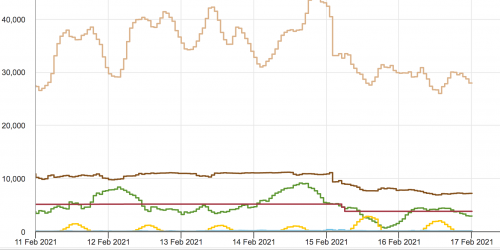Overload by Arthur Hailey
—-
Heat! Heat in stifling blanket layers. Heat that enveloped all of California from the arid Mexican border in the south to majestic Klamath Forest, elbowing northward into Oregon. Heat, oppressive and enervating…Throughout cities and suburbs, in factories, offices, stores and homes, six million electric air-conditioners hummed. On thousands of farms in the fertile Central Valley–the richest agricultural complex in the world–armies of electric pumps gulped water from deep wells, directing it to thirsty cattle and parched crops…California had known other heat waves and survived their consequences. But in none had the demands for electrical power been so great.
“That’s it, then,” the chief electric dispatcher said unnecessarily. “There goes the last of our spinning reserve.”
I was reminded of this book by the current electrical crisis in California. It is quite likely the only novel ever written in which an electrical power utility and its executives and employees are the good guys of the story.
The protagonist, Nim Goldman, is VP of Planning for Golden State Power & Light, which in the book is the predominant electrical supplier in California. The company is wrestling with the problems of accommodating growing electrical demand while facing more and more restrictions from regulators. To which difficulties are added the impact of an unprecedented heat wave and the threat of terrorist attacks.
GSP&L’s opponents fall into three overlapping circles. First, there is a mainstream and rather staid environmental organization called the Sequoia club. Then, there is an activist organization called Power and Light for People. run by an Australian named Davy Birdsong, which wants to replace for-profit utilities with some sort of government entity or collective. Finally, there is a small but deadly terrorist group which seeks maximum social disruption and sees an attack of GSP&L as the best way to achieve that goal.
The book, published in 1979, is kind of a period piece…the fuels in use are coal and oil, no mention of solar or wind; while there is concern about pollution–especially from coal–no one is talking about climate change; and while there are complaints about high electricity bills and corporate greed, no one is suggesting that Americans be weaned from most of their electricity use and forced to shut down their air conditioners. The story is well-told, although it is kind of a pot-boiler..for one thing, Nim has so much sex, and some of it under such unusual circumstances, that the actual effect is (unintentionally, I’m sure) comic. The technologies of power generation and distribution are portrayed reasonably accurately within the limitations of a popular novel. The fundamental issue of matching supply and demand continuously, in real time, comes across clearly. One character, Karen Sloan, is a quadriplegic whose very life depends upon electricity–the battery both for her assisted-breathing device and for her powered wheelchair must be periodically recharged, or else…a neat way of illustrating what a serious matter the continuity of electrical service actually is.
Overload would make a great movie, but probably could not be made in the current environment without some switching-around of good guys and villains.
